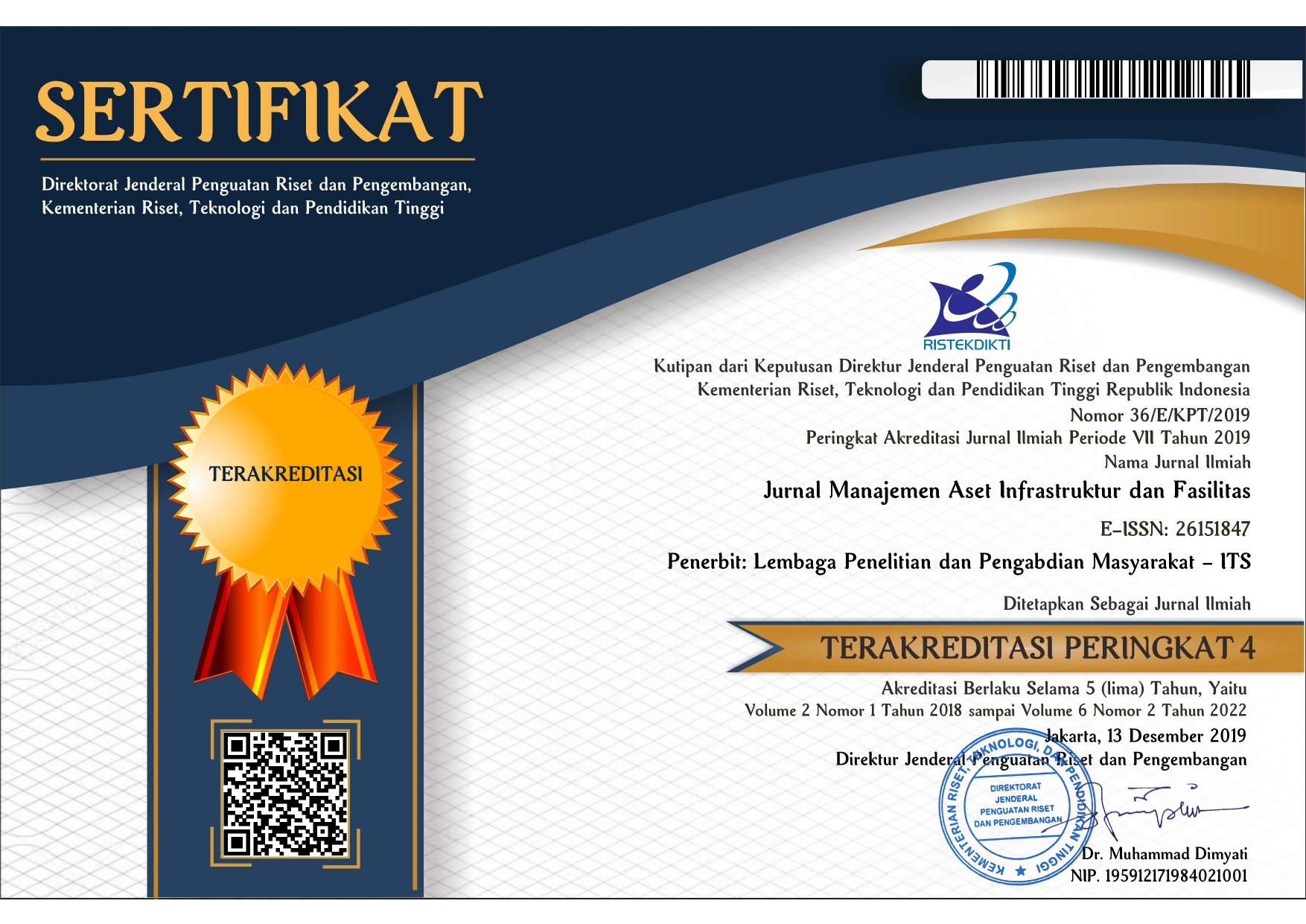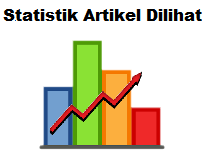Pengaruh Penambahan Mikroba untuk Meningkatkan Kepadatan Pasta Berbahan Fly Ash
Abstract
Industri konstruksi membutuhkan inovasi bahan bangunan untuk memenuhi persyaratan ekologis dan ekonomi. Bahan bangunan inovatif dapat memberikan kontribusi besar bagi efisiensi sumber daya. Studi ini dilakukan untuk mengetahui pengaruh penambahan mikroba kedalam pasta berbahan fly ash yang dapat digunakan sebagai bahan alternatif bahan konstruksi bangunan. Mikroba yang digunakan merupakan jenis sporosarcina pasteurii. Volume mikroba yang ditambahkan 0-5000 ml/m3. Pasta tersebut dimanfaatkan sebagai bahan agregat buatan. Pengujian karakterisasi agregat yang dilakukan seperti berat jenis, resapan, keausan dan porositas. Hasil pengujian karakterisasi agregat buatan kemudian dibandingkan dengan agregat natural. Hasil penelitian menunjukkan pada umur 7 hari, kuat tekan pasta dengan penambahan volume mikroba maksimum memiliki kekuatan yang lebih tinggi dan pori yang rendah. Selain itu, berat jenis agregat buatan lebih ringan daripada berat jenis agregat agregat natural. Nilai penyerapan dan keausan agregat buatan ini lebih tinggi jika dibandingkan dengan agregat natural. Pori yang lebih tinggi pada agregat buatan berdampak pada karakteristik agregat yang lebih rendah dibandingkan dengan agregat natural. Walaupun demikian, dibuktikan bahwa dari uji karakteristik, agregat buatan ini masuk dalam persyaratan dan dapat digunakan sebagai pengganti agregat natural.
Departemen Teknik Sipil, Institut Teknologi Sepuluh Nopember, SurabayaFull Text:
PDFReferences
Abdullah, A., Amirrul, K., Ku, R., Mustafa, M., Bakri, A., Hussin, K., & Tran, M. Van. (2015). “Comparison of Mechanical Properties of Fly Ash Artificial Geopolymer Aggregates with Natural Aggregate”. Applied Mechanics and Materials, 754–755(4), 290–295.
Abdulkadir, I. & Muhammed, B.S (2020). “Effect of Waste Tire Rubber on the Durability Behavior of Cement Composite: A Review”. Journal of Infrastructure & Facility Asset Management - JIFAM 2 (Sup 1) 21-34 December 2020.
Abdulkadir, I & Muhammed, B.S (2021). “Modelling and Optimization of the Compressive Strength of High Volume Fly Ash ECC with Low Modulus PVA fibre Vising Response Surface Methodology (RSM)”. Journal of Infrastructure & Facility Asset Management - JIFAM 3(1) April 2021 : 41 -58.
Bahedh, M. A. & Jaafar, M. S. (2018). “Ultra High-Performance Concrete Utilizing Fly Ash as Cement Replacement under Autoclaving Technique”. Case Studies in Construction Materials, 202, 1–20.
Cheeseman, C. R. & Virdi, G. S. (2005). “Properties and Microstructure of Lightweight Aggregate Produced from Sintered Sewage Sludge Ash”. Resources, Conservation and Recycling, 45(1), 18–30.
Chidara, R., Nagulagama, R. & Yadav, S. (2014). “Achievement of Early Compressive Strength in Concrete Using Sporosarcina pasteurii Bacteria as an Admixture”. Advances in Civil Engineering, 2014.
Duxson, P., Fernández-Jiménez, A., Provis, J. L., Lukey, G. C., Palomo, A. & Van Deventer, J. S. J. (2007). “Geopolymer Technology: The Current State of the Art”. Journal of Materials Science, 42(9), 2917–2933.
Dwi Wulandari, K., Jaya Ekaputri, J., Triwulan, Fujiyama, C. & Setiamarga, D. H. E. (2018). “Effects of Microbial Agents to The Properties of Fly Ash-Based Paste”. MATEC Web of Conferences, 195, 1–7.
Ekaputri, J., & Triwulan, T. (2013). “Sodium Sebagai Aktivator Fly Ash, Trass Dan Lumpur Sidoarjo Dalam Beton Geopolimer”. Jurnal Teknik Sipil ITB, 20(1), 1–10.
Ganesh, M., Division, G. E., Sciences, B., & Leader, D. (2011). “Experimental Study on Cold Bonded Fly Ash Aggregates”. International Journal Of Civil And Structural Engineering. 2(2), 493–501.
Hammes, F., Boon, N., De Villiers, J., Verstraete, W., & Siciliano, S. D. (2003). “Strain-Specific Ureolytic Microbial Calcium Carbonate Precipitation”. Applied and Environmental Microbiology, 69(8), 4901–4909.
Haruna, S., Muhammed, B.S. & Wahab M.A. (2020). “Effect of GGBS Slag on setting Time and Compressive Streng of One – Part Geopolymer Binders”. Journal of Infrastructure & Facility Asset Management - JIFAM 2(2) September 2020 : 149-160”.
Hilda Yuliana, A., Dewa Made Alit Karyawan, I., Murtiadi, S., Ekaputri, J. J., & Ahyudanari, E. (2019). “The Effect of Slope Granulator on The Characteristic of Artificial Geopolymer Aggregate Used in Pavement”. Journal of Engineering Science and Technology, 14(3), 1466–1481.
I Dewa, M. A. K., Januarti, J. E., Iswandaru, W. & Ervina, A. (2019). “The Effects of Na2SiO3/NaOH Ratios on The Volumetric Properties of Fly Ash Geopolymer Artificial Aggregates”. Materials Science Forum, 967, 228–235.
Jaya Ekaputri, J., Syabrina Mutiara, I., Nurminarsih, S., Van Chanh, N., Maekawa, K. & Setiamarga, D. H. E. (2017). “The Effect of Steam Curing on Chloride Penetration in Geopolymer Concrete”. MATEC Web of Conferences, 138.
Kockal, N. U. & Ozturan, T. (2011). "Durability of Lightweight Concretes with Lightweight Fly Ash Aggregates". Construction and Building Materials, 25(3), 1430–1438.
Mangialardi, T. (2001). "Sintering of MSW Fly Ash for Reuse as a Concrete Aggregate". Journal of Hazardous Materials, 87(1–3), 225–239.
Manso, S., Calvo-torras, M. Á., Belie, N. De, Segura, I. & Aguado, A. (2015). "Science of the Total Environment Evaluation of Natural Colonisation of Cementitious Materials: Effect of Bioreceptivity and Environmental Conditions". Science of the Total Environment, The, 512–513, 444–453.
Mustafa, A. M., Bakri, A., Kamarudin, H., Bnhussain, M., Nizar, I. K., Rafiza, A. R. & Zarina, Y. (2011). "Microstructure of Different NaOH Molarity of Fly Ash-Based Green Polymeric Cement". Journal of Engineering and Technology Research, 3(2), 44–49.
Park, S. J., Park, Y. M., Chun, W. Y., Kim, W. J. & Ghim, S. Y. (2010). "Calcite-Forming Bacteria for Compressive Strength Improvement in Mortar". Journal of Microbiology and Biotechnology, 20(4), 782–788.
Rahmadina, A. & Ekaputri, J. J. (2017). “Mechanical Properties of Geopolymer Concrete Exposed to Combustion”. MATEC Web of Conferences. 138, 1-10.
Sadath Ali, M. K. (2015). “Self Healing Concrete and Asphalt”. Journal of Civil Engineering and Environmental Technology, 2(16), 27–33.
Singh, B., Ishwarya, G., Gupta, M. & Bhattacharyya, S. K. (2015). “Geopolymer Concrete: A Review of Some Recent Developments”. Construction and Building Materials, 85, 78–90.
Škvára, F., Jílek, T. & Kopecký, L. (2005). “Geopolymer Materials Based on Fly-Ash”. Ceramics - Silikaty, 49(3), 195–204.
Suprayitno, H., & Soemitro, R.A.A. (2018). “Preliminary Reflexion on Basic Principle of Infrastructure Asset Management”. Jurnal Manejemen Aset Infrastruktur & Fasilitas – JMAIF 2(1): 1–10 Maret, 2018.
Wang, K. S., Sun, C. J., & Yeh, C. C. (2002). “The Thermotreatment of MSW Incinerator Fly ash for Use as an Aggregate: A Study of The Characteristics of Size-Fractioning”. Resources, Conservation and Recycling, 35(3), 177–190.
Widayanti, A., Soemitro, R.A.A, Ekaputri, J. J. & Suprayitno, H. (2018). “Kinerja Campuran Aspal Beton dengan Reclaimed Asphalt Pavement dari Jalan Nasional di Provinsi Jawa Timur”. Jurnal Manajemen Aset Infrastruktur & Fasilitas - JMAIF 2(1), Marc 2020 :35–43.
Widayanti, A., Soemitro, R.A.A, Ekaputri, J.J & Suprayitno, H. (2019). “Gradation Analysis of Reclaimed Asphalt Pavement from National Rood as Asphalt Concrete Layer”. Journal of Infrastructure & Facility Asset Management - JIFAM 1(1) March 2019.
DOI: http://dx.doi.org/10.12962%2Fj26151847.v5i3.15358
Refbacks
- There are currently no refbacks.
Jumlah Pengunjung :
Flag Counter

Jurnal Manajemen Aset Infrastruktur & Fasilitas by Departemen Teknik Sipil ITS is licensed under a Creative Commons Attribution-ShareAlike 4.0 International License.





